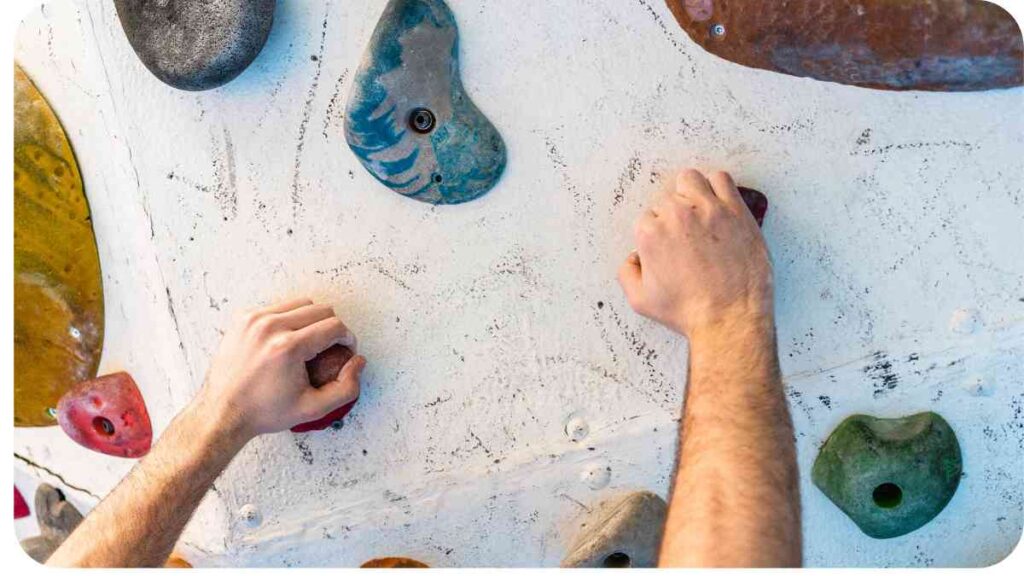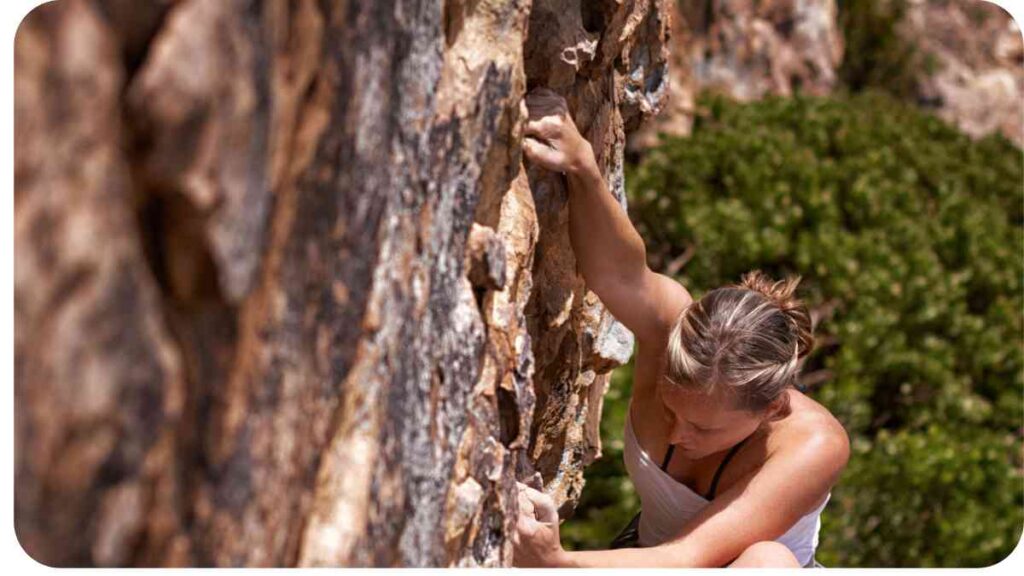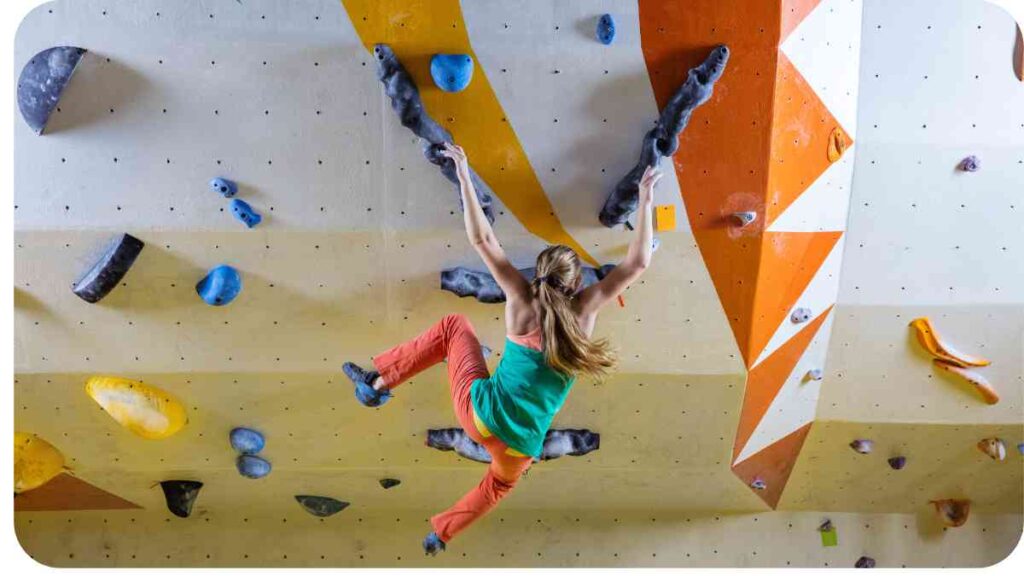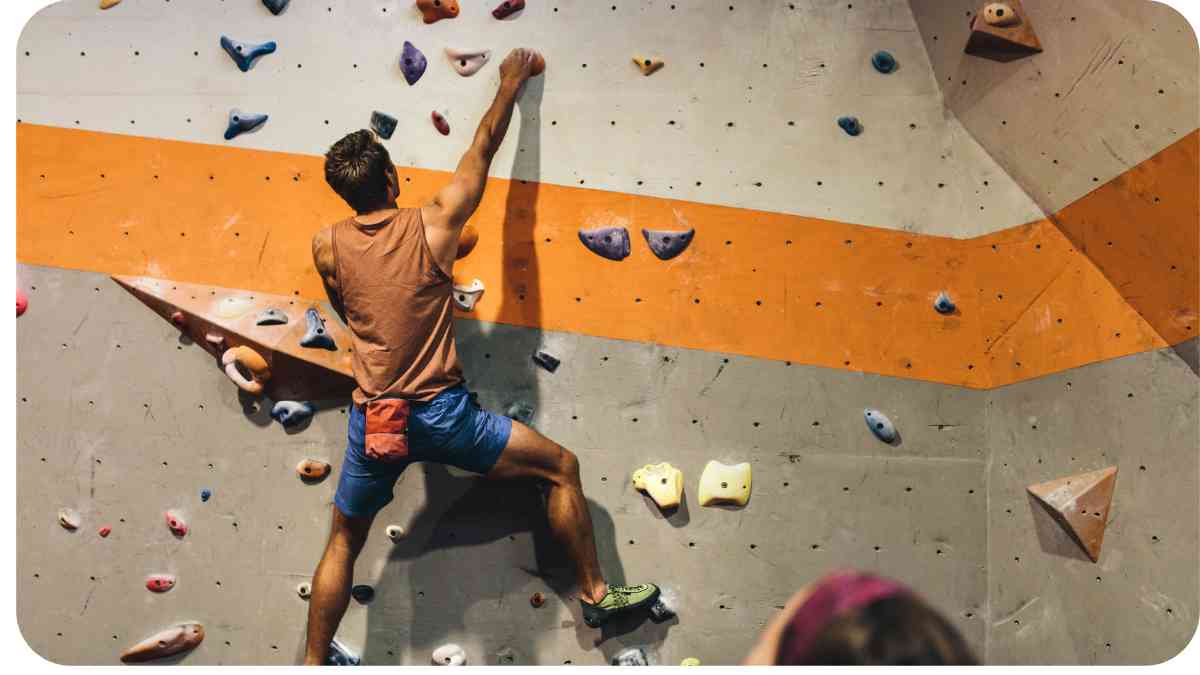Welcome to “Grip Slipping During Bouldering: How to Improve Your Hold.” Bouldering is an exhilarating and challenging form of rock climbing that requires strength, technique, and mental focus.
One of the most common difficulties climbers face is grip slipping, which can be frustrating and hinder progress. In this article, we will explore the reasons behind grip slipping and provide practical tips and techniques to enhance your grip and overall climbing ability.
| Takeaways |
| – Understanding different types of rock climbing holds and how to approach them properly. |
| – Tips and techniques for improving grip on slopers, which can be challenging to grip. |
| – Comprehensive guide on gripping different climbing holds, providing insights on optimal techniques and grip positions. |
| – Recommendations for training grip strength, including exercises and frequency. |
| – Options for improving grip strength at home without specialized climbing facilities or equipment. |
| – Importance of proper technique and hand positioning in preventing grip slipping. |
| – Exploring the use of liquid chalk and powdered chalk for improved grip. |
| – Strategies for handling sweaty hands and reducing moisture to maintain a solid grip. |
2. Understanding the Grip
A solid grip is crucial for bouldering success. It allows you to maintain control, support your body weight, and execute precise movements. Your grip strength relies on the coordination of various muscle groups, particularly the fingers, forearms, and wrists.
Mastering bouldering requires more than strength alone. Here are valuable tips to sharpen your skills overnight. Understand the nuances of balance, technique, and grip pressure. These insights will elevate your bouldering prowess.
3. Common Causes of Grip Slippage

Insufficient chalk application
Chalk is a climber’s best friend when it comes to maintaining a reliable grip. It helps absorb sweat and moisture from the hands while providing a dry and rough surface for friction on holds. A lack of proper chalk application can lead to a decrease in grip strength, resulting in slipping.
To combat this, ensure you adequately chalk your hands before attempting a climb. Experiment with different types of climbing chalk to find what works best for you and be sure to reapply as needed throughout your session.
Table: Recommended Chalk Brands
| Brand | Features | Price Range |
| Black Diamond | High-quality magnesium carbonate | $-$$ |
| Friction Labs | Fine texture with long-lasting grip | $$ |
| Metolius | Affordable and effective | $ |
| Mammut | Non-toxic and easy to apply | $$ |
Sweating and moisture
Even with proper chalk application, sweating can still affect your grip. Intense physical exertion, high temperatures, and anxiety can all contribute to sweaty palms, making it challenging to maintain a secure hold. Moisture can also accumulate on the climbing holds themselves, reducing friction.
To counteract sweaty hands, consider using a chalk bag that attaches to your waist or harness. These bags remain easily accessible during climbs, allowing you to reapply chalk quickly. Additionally, take short breaks between attempts to wipe off excess sweat and chalk up again.
Conquering the bouldering wall demands strategy and finesse. Learn essential tricks to dominate. Proper foot placement, precise handholds, and body positioning are key. Enhance your bouldering experience with expert guidance.
Table: Popular Chalk Bags
| Brand | Features | Price Range |
| Petzl | Compact and lightweight | $-$$ |
| Mammut | Adjustable belt and brush pocket | $$ |
| Black Diamond | Dual-compartment design | $ |
Poor hand positioning
The way you position your hands on climbing holds significantly affects your grip strength. Placing your hands incorrectly or failing to engage the proper muscle groups can lead to grip slipping. It’s essential to develop awareness of hand positioning and make adjustments as necessary.
Trial and error plays a role in finding the most effective hand positioning for different holds. Experiment with various grips, hand sizes, and finger orientations to determine what works best for you. Over time, you will develop an intuitive sense of how to optimize your hand positioning for different climbing scenarios.
Weak finger and forearm strength
Having weak finger and forearm strength can contribute to grip slipping during bouldering. These muscles are essential for generating the necessary force to hold onto small holds and maintain control.
To improve your grip strength, incorporate specific exercises into your training routine. Finger curls, finger extensions, and hangboard workouts are all effective in targeting the muscles involved in gripping. Gradually increase the intensity and duration of these exercises to build strength over time.
Table: Effective Finger and Forearm Exercises
| Exercise | Muscles Targeted |
| Finger curls | Forearm flexors and finger muscles |
| Finger extensions | Forearm extensors and finger muscles |
| Hangboard workouts | Finger flexors and forearm muscles |
Note: It’s crucial to approach these exercises with caution and gradually increase the intensity to avoid injury. Consult with a professional or experienced climber to ensure proper form and technique.
Bouldering welcomes enthusiasts of all levels. Explore the best techniques tailored for your skill. Whether you’re a beginner or seasoned climber, these techniques refine your abilities. Elevate your bouldering game and overcome challenging routes.
4. Essential Techniques for a Stronger Grip

In addition to building strength in your fingers and forearms, there are several essential techniques you can employ to improve your grip for bouldering.
Finger and wrist exercises
Incorporate regular finger and wrist exercises into your training routine to strengthen the muscles and tendons involved in gripping. Squeezing stress balls, using grip strengtheners, and performing wrist curls with dumbbells are all effective exercises. These exercises not only enhance grip strength but also improve flexibility and coordination.
Table: Hand and Wrist Strengthening Exercises
| Exercise | Technique |
| Stress ball squeezes | Squeeze a stress ball in your hand, holding for a few seconds, and then release. Repeat for several sets. |
| Grip strengtheners | Utilize grip strengtheners, such as Hand Grippers, to improve hand and forearm strength. Start with a comfortable resistance and gradually increase. |
| Wrist curls | Hold a dumbbell with an underhand grip, rest your forearm on a surface, and curl your wrist upward, then return to the starting position. |
Grip strength training
Dedicate specific training sessions to focus on grip strength. Hangboarding, fingerboarding, and campus board exercises are popular methods for improving grip strength in climbers. These exercises target finger and forearm muscles, enhancing their strength and endurance.
Witness the extraordinary feats of bouldering pioneers. Discover the most insane and awe-inspiring accomplishments in bouldering history. These climbers redefine limits and showcase unparalleled determination. Be inspired by their remarkable journeys and achievements.
Table: Grip Strength Training Tools
| Tool | Description |
| Hangboard | A stationary board with various finger holds |
| Fingerboard | A board with specific finger holds for static exercises |
| Campus board | A training board with ascending rungs for dynamic exercises |
Hand position optimization
Proper hand positioning is essential for a strong grip. Mastering different hand positions allows you to adapt to a variety of holds and terrain. Experiment with open-handed crimps, closed crimps, and sloper grips, and observe how each hand position affects your grip strength and stability.
Remember to maintain a relaxed grip whenever possible. Over-gripping can lead to fatigue and premature slipping. Practice finding the right balance between grip strength and energy conservation.
5. Equipment and Gear Recommendations
Having the right equipment and gear can significantly impact your grip and overall climbing performance. Here are some recommendations for essential bouldering gear:
Climbing shoes
Investing in a quality pair of climbing shoes that fit snugly is crucial for maximizing grip. Climbing shoes should provide a balance between comfort and sensitivity, allowing you to feel the holds while offering adequate support.
Table: Popular Climbing Shoe Brands
| Brand | Features | Price Range |
| La Sportiva | Precision fit with excellent grip | $$-$$$ |
| Five Ten | Stealth rubber for superior friction | $$-$$$ |
| Scarpa | Versatile performance for all types of boulders | $$-$$$ |
Chalk and chalk bag
As previously mentioned, using chalk effectively reduces moisture and improves grip. A chalk bag that attaches to your waist or harness is essential for easy access during climbs.
Achieving a perfect grip is pivotal in bouldering. Explore solutions to chalk consistency issues. Find the optimal balance for enhanced grip. Uncover the science behind chalk and learn to maintain consistent friction. Elevate your bouldering performance effortlessly.
Table: Chalk Bag Options
| Brand | Features | Price Range |
| Petzl | Compact and lightweight | $-$$ |
| Mammut | Adjustable belt and brush pocket | $$ |
| Black Diamond | Dual-compartment design | $ |
Finger tape and skin care products
Frequent climbing can take a toll on your skin, leading to calluses, blisters, or flappers. Protect your fingers with climbing-specific finger tape or finger sleeves. Moreover, consider using skin care products to prevent excessive dryness or cracking.
Table: Recommended Finger Tape and Skin Care Brands
| Brand | Features | Price Range |
| Metolius | Self-adhesive and durable | $-$$ |
| Black Diamond | Tear-resistant and breathable | $-$$ |
| Climb On | Natural ingredients and moisturizing properties | $$ |
Climbing brushes
Cleaning climbing holds of excess chalk and dirt is essential for maintaining optimal grip. A climbing brush with stiff bristles is useful for removing debris and improving friction.
Table: Recommended Climbing Brush Brands
| Brand | Features | Price Range |
| Black Diamond | Durable and compact | $-$$ |
| Metolius | Nylon bristles and ergonomic handle | $ |
| Beta Designs | Small and lightweight | $ |
By investing in high-quality climbing shoes, utilizing chalk and chalk bags effectively, protecting your fingers with tape and skin care products, and using climbing brushes to clean holds, you can optimize your grip and overall climbing experience.
6. The Role of Mental Focus
Grip slipping is not always solely due to physical factors. Your mental focus plays a vital role in maintaining a solid grip. Here are some techniques to develop mental strength and enhance your grip during climbs.
Visualizing success
Before attempting a climb, visualize yourself successfully completing the moves and maintaining a solid grip. Engaging in mental imagery can help improve focus, confidence, and muscle memory.
Managing fear and anxiety
Fear and anxiety can negatively impact your grip and overall performance. Develop strategies to manage these emotions, such as controlled breathing techniques, positive self-talk, and progressive exposure to challenging climbs.
Building confidence
Confidence in your abilities can greatly improve your grip. Celebrate small victories, set achievable goals, and focus on improving technique and strength. The more confident you feel, the better you will be able to maintain a strong grip.
7. Troubleshooting Solutions for Grip Slipping

If you are experiencing consistent grip slipping despite incorporating various techniques, here are some troubleshooting solutions to consider.
Adjusting grip technique
Experiment with different grip techniques, hand placements, and finger positions on holds. Analyze how each adjustment affects your grip strength and adapt accordingly.
Trying different holds
Not all holds are created equal, and some may be more challenging to grip than others. Practice on a variety of holds, including slopers, crimps, and pockets, to expose yourself to different textures and angles.
Seeking professional instruction
Sometimes, grip slipping can be a result of technical flaws in your climbing technique. Seeking guidance from a qualified instructor or coach can provide valuable insights and help you correct any weaknesses.
Analyzing body positioning
Ensure that your body positioning is optimal for maintaining a solid grip. Pay attention to your hips, center of gravity, and weight distribution. Making adjustments to your body positioning can greatly improve your grip stability.
Remember, troubleshooting grip slipping may require time and patience. Be persistent in trying different techniques and seeking guidance when needed.
8. Useful Tips for Bouldering Success
In addition to focusing on grip strength and technique, incorporating these useful tips into your bouldering routine can contribute to your overall success.
Warm-up exercises
Before starting your bouldering session, engage in warm-up exercises to increase blood flow, loosen up your muscles and joints, and prevent injuries. Dynamic stretches, light cardio, and mobility exercises specific to climbing movements are great warm-up options.
Rest and recovery
Allow your body sufficient time to rest and recover between climbing sessions. Overtraining can lead to fatigue and decreased grip strength. Listen to your body’s signals and incorporate rest days and active recovery routines into your climbing schedule.
Proper nutrition and hydration
Fueling your body with the right nutrients and staying hydrated is crucial for maintaining optimal grip strength and overall performance. Eat a well-balanced diet that includes protein, carbohydrates, healthy fats, and micronutrients. Hydrate adequately before, during, and after climbing sessions.
Listening to your body
Pay attention to any discomfort or pain during climbing. Pushing through pain can lead to injuries and hinder your progress. Take breaks when necessary, and don’t be afraid to modify your workouts based on how your body feels.
By incorporating these tips into your bouldering routine, you can improve your grip, prevent injuries, and enhance your overall climbing performance.
Continue to the next response for more valuable insights, personal stories, anecdotes, and answers to frequently asked questions.
9. Strategies for Overcoming Plateaus
Plateaus are a common occurrence in climbing, and they can be frustrating. When it comes to grip slipping, you might feel stuck and unable to progress. Here are some strategies to help you overcome plateaus and continue improving your grip:
Mixing up your training routine
Repeating the same exercises and climbing routes can lead to stagnation. Challenge your muscles and grip by introducing new exercises, climbing styles, and climbing routes. Cross-training with activities like weightlifting, yoga, or finger strength exercises can also help break through plateaus.
Setting goals and tracking progress
Establish specific and achievable goals to work towards. This can help you stay motivated and focused on improving your grip strength. Track your progress by keeping a climbing journal or using climbing apps that allow you to record your climbs, grades, and improvements over time.
Joining a climbing community
Surrounding yourself with a supportive climbing community can provide motivation, feedback, and guidance. Join a local climbing gym, participate in climbing competitions, or connect with other climbers online. Sharing experiences and learning from others can help you overcome grip slipping plateaus.
Cross-training with complementary exercises
Improving grip strength can also involve training other muscle groups. Incorporate exercises that target core strength, shoulder stability, and overall body strength. Strengthening these areas can enhance your overall climbing abilities, including your grip.
10. Personal Stories and Anecdotes
Personal stories and anecdotes can provide valuable insights and inspiration. Here is a collection of stories from climbers who have faced grip slipping challenges, memorable climbing experiences, and lessons learned from setbacks:
- Climber A: “I used to struggle with grip slipping in the beginning. However, through consistent finger and forearm exercises, optimizing my hand positioning, and using high-quality climbing chalk, I was able to improve my grip strength significantly. It took time, but the progress was worth it.”
- Climber B: “I had a memorable climbing experience on a difficult boulder problem. My grip was slipping, and I was getting frustrated. Instead of giving up, I took a moment to breathe, readjusted my grip, and focused on staying calm. With mental focus and determination, I was able to complete the problem successfully.”
- Climber C: “I faced a setback when I injured my wrist during a climbing session. It was frustrating, and I couldn’t climb for a few weeks. However, during my recovery, I focused on strengthening my grip through finger exercises and forearm workouts. It taught me the importance of taking care of my body and gradually building strength to prevent future injuries.”
These personal stories remind us of the challenges climbers face and the various strategies and lessons learned from those experiences.
11. Frequently Asked Questions
How long does it take to improve grip strength?
The time it takes to improve grip strength varies depending on individual factors such as starting strength, training consistency, and genetics. Consistently incorporating grip-strengthening exercises, training techniques, and techniques for grip optimization can lead to noticeable improvements within a few months.
Is grip slipping more common for beginner climbers?
Grip slipping can affect climbers of all levels, from beginners to advanced climbers. Beginners may experience grip slipping more frequently due to lack of experience and grip strength. However, as climbers develop better technique and strength, grip slipping becomes less frequent.
Can grip slipping be prevented entirely?
While it’s difficult to prevent grip slipping entirely, implementing the techniques and strategies mentioned in this article can significantly minimize the occurrence. Regularly training grip strength, optimizing hand positioning, using chalk effectively, and maintaining mental focus can all contribute to a stronger and more secure grip.
12. Conclusion
Grip slipping can be a frustrating obstacle in bouldering, hindering progress and performance. However, by understanding the causes of grip slipping and implementing the techniques and strategies mentioned in this article, you can develop a stronger grip and improve your bouldering abilities.
Remember to focus on improving grip strength through training exercises, optimizing hand positioning, using appropriate gear and equipment, and developing mental focus. Incorporating these strategies, along with patience and consistency, will help you overcome grip slipping challenges and enjoy a more successful and rewarding bouldering experience.
Further Reading
Here are some additional resources that you may find helpful in exploring further information on improving grip strength and overcoming grip slipping:
- All Rock Climbing Holds and How to Master Them: This guide provides an in-depth overview of various rock climbing holds, including crimps, slopers, jugs, and more. It offers insights on how to approach and conquer each type of hold.
- How to Climb: Practice Slopers: This article from Climbing.com focuses specifically on slopers, a type of climbing hold often challenging for grip stability. It provides tips and techniques for improving your sloper climbing skills.
- Gripping Climbing Holds: A Comprehensive Guide: Climb Hangout offers a comprehensive guide on gripping different types of climbing holds. It covers various techniques and grip positions for optimal grip strength and control.
FAQs
Here are some frequently asked questions about grip strength and overcoming grip slipping:
Q: How often should I train my grip strength?
A: It’s recommended to incorporate grip strength training exercises 2-3 times a week, allowing for sufficient rest and recovery between sessions to prevent overuse injuries.
Q: Can I improve my grip strength without access to climbing facilities or equipment?
A: Yes, there are exercises you can do at home to improve grip strength, such as finger curls, using grip strengtheners, and performing bodyweight exercises like pull-ups and dead hangs.
Q: Can grip slipping be caused by improper technique?
A: Yes, grip slipping can be a result of improper hand positioning, failing to engage the proper muscles, or overly tight grip. Focusing on proper technique and practicing optimal hand placements can significantly reduce grip slipping.
Q: Should I use liquid chalk or powdered chalk for better grip?
A: The choice between liquid chalk and powdered chalk depends on personal preference. While liquid chalk offers longer-lasting grip and less mess, some climbers prefer the feel of powdered chalk. Experiment with both to see which works best for you.
Q: What can I do if my hands get sweaty and affect my grip?
A: If sweaty hands are an issue, using antiperspirant hand creams or specialized chalks for sweaty hands can help reduce moisture and improve grip. Additionally, carrying a small towel to dry your hands between climbs can be beneficial.

Welcome to my blog! I’m Hellen James, and I’m incredibly passionate about rock climbing, bouldering, ice climbing, and mountaineering. Join me as I embark on thrilling adventures, conquer vertical challenges, and share my experiences and insights with fellow outdoor enthusiasts.


